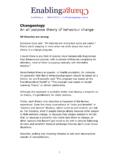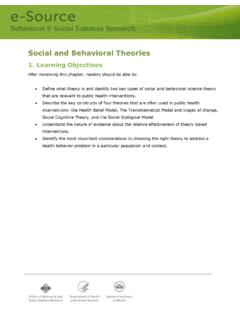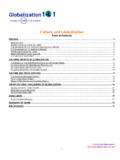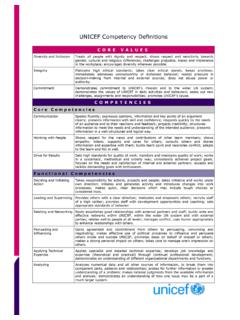Transcription of Subir Bhattacharjee ExxonMobil Development …
1 Design and Installation Challenges for Deepwater Mooring Systems Subir Bhattacharjee ExxonMobil Development company Introduction A large number of new offshore Development is occurring in deepwater remote locations using floating production systems. Simple extrapolation of the shallow water experience may not be adequate for mooring systems in the deeper waters. The present paper, based primarily on some recent West Africa floating production storage and offloading (FPSO) project experience, outlines several challenges in the design and installation process to ensure a reliable and cost effective mooring system. The discussion focuses more on the design aspect and touches on some installation issues as well. The primary focus is on conventional steel mooring system in taut leg configuration, using suction anchors, bottom chain, steel wire rope and top chain. Steel mooring systems have a longer industry history and are considered to be relatively robust in handling.
2 Although synthetic moorings are not discussed specifically, several of the issues raised here are relevant for synthetic mooring systems, too. Design & Analysis: The design and analysis of mooring systems for deepwater poses several challenges, some that are obvious and some that are more subtle in nature. The following sections highlight some of the key areas requiring attention. Metocean Criteria Development First, there is the challenge of gathering quality data for the site within the required timeframe. Early planning for the data gathering is usually economical and helps reduce unnecessary conservatism in design. Even when good data is available, appropriate criteria Development is still challenging for these floating systems. A good understanding of the system's dynamic response is required to specify the design criteria and identify environmental "extreme cases" to be analyzed. The metocean specialist and the mooring specialist need to work together to develop the response based design criteria.
3 Definition of extreme environment and the associated environment can both be critically important and may have significant influence on the design. For example, a 100-year return wind condition may be defined as one of the extreme environment cases. The associated environment may be the 95% non-excedence wave and current condition that should be applied simultaneously for the design. To appropriately specify the associated environment, the metocean specialist needs to understand the sensitivity of the system dynamic response to both the magnitude and direction of the associated environment. Due to system damping characteristics, the use of the most severe associated environment to go along with the extreme design environment may not be the most conservative scenario for mooring design. Contrary to intuition, in some situations, the absence of the associated environment may produce a higher response.
4 Page 1 of 6. Mooring design in West Africa poses a set of additional challenges such as the simultaneous presence of the local seas and regional swells and the presence of short duration squalls with rapidly changing wind directions during a storm. The database for squalls is still quite limited and is based on a relatively short observation period. This introduces an uncertainty in extrapolation of 100-year return squall conditions. More data on extreme squalls, including the frequency content of the gusts and their spatial coherence will help us better design FPSO. moorings. Joint effort in this area could benefit the entire industry. Analysis Tools A reliable and cost effective mooring design requires a combination of an experienced engineering team, availability of appropriate analysis tools, and a project management structure that enables high technical performance. A deficiency in any one of these resources can result in a design that is less than optimum.
5 Assuming that we have a perfect team working under a perfect structure, let us focus on the analysis tools. Although multiple analysis software tools are available in the market, each has its own limitations. There are choices to be made at several levels. Choices have to be made between a integrated software (for combined hydrodynamics and mooring analysis capability) or separate programs for each task with interfaces. This has significant impact on the design cycle for some systems where system dynamic behavior has strong interactions between the mooring and the floater ( offloading buoys in deepwater). There is also the battle between time domain versus frequency domain analysis. The analyst has to identify what best suits the task at hand and make appropriate allowances for shortcomings in the software. The role of damping from all sources still continues to be an important parameter influencing the slow-drift response.
6 The software used should be critically examined for its treatment of the damping contributions, limitations identified, and suitable allowances incorporated in the design margin. The complexity of the various extreme conditions and the fatigue conditions to be analyzed often require analysts to switch analysis tools for the different tasks. For example, the fatigue analysis may be more suitably done with a frequency domain software while the squall analysis requires a time domain analysis tool. When such changes are required, benchmarking predictions of different software against each other with some common cases is essential for consistent predictions. Also, any tool should be benchmarked or verified against model tests, before it is accepted for critical design decisions. Model Tests Model tests are a valuable tool for assisting the design of complex systems. However, model tests can only shed light on attributes that one has properly modeled, measured and is able to justify with a sound technical basis.
7 For floating systems, wind tunnel tests for wind and current loads and wave basin tests for motion response and mooring loads are commonly performed. For wind tunnel tests there are few critical areas that need special attention. The building of the scale model for wind tunnel testing is a process that involves judgement on the part of the model builder to make "equivalent approximations" of complex topsides equipment. This is an area that can exhibit considerable variability based on the experience and practice followed by the individual wind tunnel facilities. Typically, the primary members of the modeled structure are well represented. However, when it comes to the secondary members like small piping, spool pieces, and small Page 2 of 6. appendages, the practice seems to vary widely. Careful checks of this modeling process and the underlying assumptions are extremely important. Benchmarking of the test set-up is another area that can significantly add confidence to the test results by identifying potential instrument problems.
8 Using a simple block like a cube to measure the force and correlate it with calculated values is a simple but reliable check. Also, the symmetry of the block can help with some additional checks on the instrumental set-up. For wave basin tests of complex floating systems, the need for systematic testing of the floater alone, floater with moorings and finally floater with moorings and risers is essential. This provides a building block approach that can be used to perform systematic checks very efficiently. Frequently, the need for economy in the testing budget forces the project to bypass some of the steps and this can make a systematic understanding of various contributing factors almost impossible. Numerous technical challenges are faced in the model test program. These include modeling the full deepwater mooring system, appropriate modeling of viscous forces in a Froude scaling environment, simultaneous modeling of vessel motions and dynamic line tensions.
9 Given the time, resources and oversight, the test facilities can adequately address all the issues to a high degree of accuracy. However, the challenge for the designer is to strike an optimum balance between quality, cost, and schedule. Prediction of Design Maximum Considerable scatter exists in the statistical interpretation of dynamic simulations, both from model tests and numerical simulations. Design values selected vary widely from absolute maximum value to average of max value, with biased average of the maximum value falling in between. This is an area where industry needs to better define the design maximum or the "most probable maximum" value. West Africa squalls present another unique challenge by their short transient nature and the need to derive response statistics from a short time history sample. Analysis of multiple squall time series with varying initial conditions is recommended.
10 Strength Design and Fatigue Design Traditionally, shallow water mooring systems in most parts of the world (except North Atlantic type environment) are designed to meet strength requirements and typically satisfy fatigue requirements. This is no longer true for deepwater systems. The pretensions are normally higher for deepwater systems and the taut nature of the mooring system results in dynamic tensions that are significantly higher under moderate wave conditions. For deepwater moorings in West Africa, fatigue is beginning to play a dominant role. This is especially true for the mooring chain. The widespread use of studless chain with lower fatigue life has made the problem more acute. Modern mooring designs typically utilize groups of mooring lines to provide redundancy in the event of a line failure. Spread moored systems typically have mooring lines in groups at each of the four quadrants of the FPSO while turret moored vessels utilize three groups of mooring legs.











